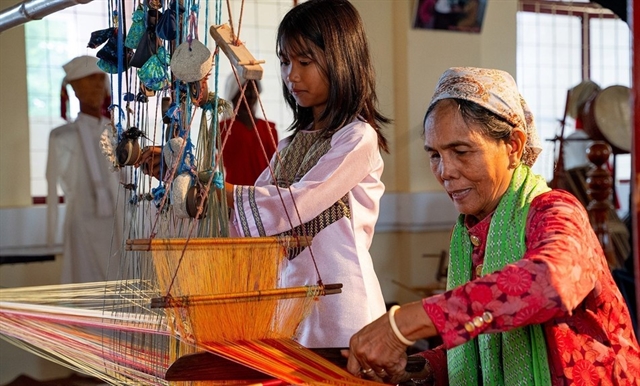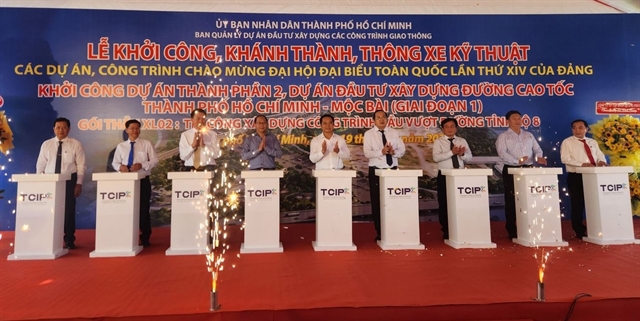 Features
Features

Fed up with the mass-produced items, Nguyễn Đức Huy pursues natural living, making his own fabric dyes from sustainably-sourced plants.
By Vân Nguyễn & Minh Phương
Textile artist Nguyễn Đức Huy dips a piece of white silk fabric into a red plant-based dye, swirls it around and turns the material over and over to make sure the natural colour is evenly absorbed.
The 28-year-old from Hà Nội has been dyeing fabric naturally for years.
“I came to fabric dyeing to pursue a natural living,” Huy said.
Fed up with the mass-produced items, Huy decided to pursue a more natural living style, making his own fabric dyes from sustainably-sourced plants.
The artist now owns a store selling naturally dyed textiles and traditional Vietnamese garments made with eco-friendly colouring.
Nguyễn Thị Hồng Trang, a founder of a cosmetic start-up in Germany, is a big fan of traditional costumes using natural materials.
As a woman born in the former imperial capital city of Huế, who is passionate about culture now living in Germany with her husband and daughter, Trang bought the first designs made by Huy in 2018 and now has a collection of traditional costumes in her wardrobe.
Áo nhật bình, one of the casual clothes of the Empress dowager, Empress consort, and princesses in the imperial city of the Nguyễn Dynasty, was the first royal costume that Huy made.
“The designs are very nice. Once I buy one, I want to buy another. I am so into them,” Trang said.
She often wears them at special events where she has the chance to introduce Vietnamese culture to her western friends.
“I want to wear traditional costumes often, so my daughter feels a sense of closeness to Vietnamese culture, and I hope this will help nurture a love for it in her,” Trang said.

|
| No Title |
Huy’s passion for natural dyeing cloth came from his love of DIY crafts.
He likes to do everything himself and has attended many workshops on making notebooks, leather, papers, sewing and dyeing fabric.
He found a love for handicrafts when studying in Germany.
“I realised that everything in our life is created industrially, and it made me learn to appreciate more natural handiwork,” he said.
“Handicrafts in Germany have a much higher value than in Việt Nam, but they are difficult to find. In Việt Nam, we can see them much more often compared to developed countries, and the cost is not too high. I was impressed with the indigo dyeing workshop the most.

|
| No Title |
“Indigo dye is different from other dyes because we have to grow the microorganisms. I feel that this is not just a craft, but rather it’s like I am taking care of a living creature.”
A couple of years ago, Huy travelled to Sa Pa and spent a month with a Mông ethnic family to learn about indigo dyeing. Many ethnic minorities in Việt Nam have maintained natural dyeing techniques for centuries.
“As ethnic people became more exposed to mass-produced items, some gave up on natural or handmade items,” Huy said.
“Though many shifted to chemical dyes, many young ethnics have realised the need to preserve their traditional craft. They also understand the potential of vegetable dyes, which will bring much higher values than the normal industrial stuff.”

|
| Traditional costumes using naturally dyed textiles are a favourite of Trang (right), a founder of a cosmetic start-up in Germany. Photo courtesy of Trang |
After three years, Huy now can make basic colours including blue, red, yellow and brown, and dozens more by mixing them.
Medicinal herbs and fruit scraps are the main ingredients Huy uses to colour fabric.
“Medicinal herbs’ pharmaceutical features make them a good ingredient for dye. It also absorbs very well into the fabric. Natural dyes emit fewer toxins in the environment, and many of them also have interesting qualities that are good for us,” he said.
Natural indigo dye has antibacterial quality, so, in the old days, firefighters wore indigo-dyed garments so if they got injured, it would help protect their bodies from infection.
“Some ethnic groups use medicinal herbs as ingredients for fabric dyes and say that wearing vegetable-dyed garments will make them healthier,” the 28-year-old said.
Huy uses scrap fruits and plants such as lychee peel, custard apple peel, pomegranate peel, mugwort or Indian almond leaves, which are easy to find.

|
| No Title |
His naturally dyed fabric is a favourite of those who prefer eco-friendly products. Young men and women in their 20s and 30s are fascinated with traditional garments made with eco-friendly colouring.
“My customers are quite young, from high school age to about 30. These are the main customers of the traditional clothes segment. For naturally dyed fabric, our customers are those who have worked for a couple of years and have better financial resources and start to like natural stuff.”
Natural dyeing has become a popular trend among young fashionistas throughout the country. They prefer using natural dyes to protect the environment and see it as a way to revive an eco-friendly lifestyle that has long been forgotten in the wake of industrialization.
Huy plans to make his products more diverse by adding patterns to the naturally dyed textiles.
“I will use beeswax or other techniques to create patterns on the fabric. Doing so will help attract more young people to my products,” he said. VNS